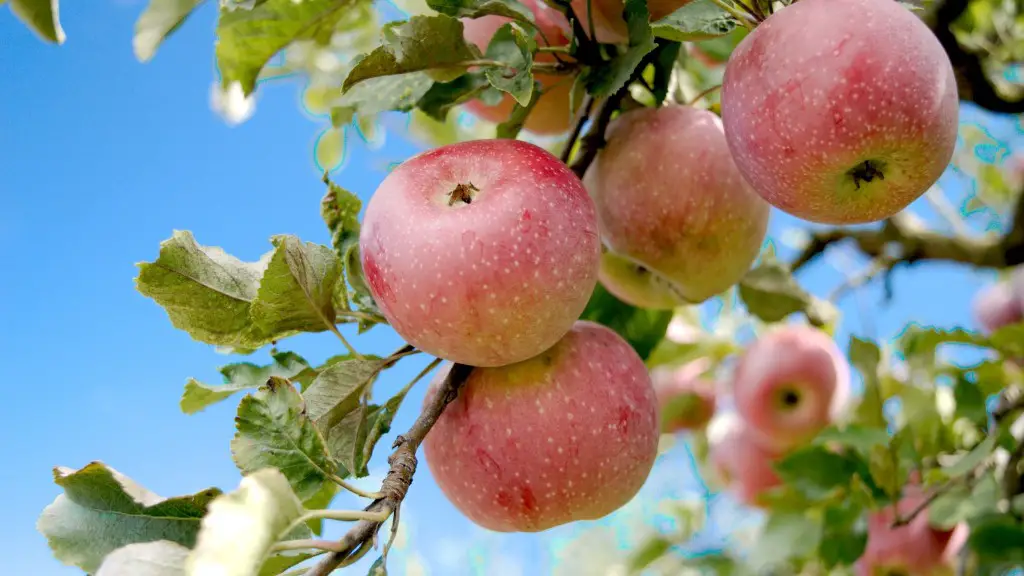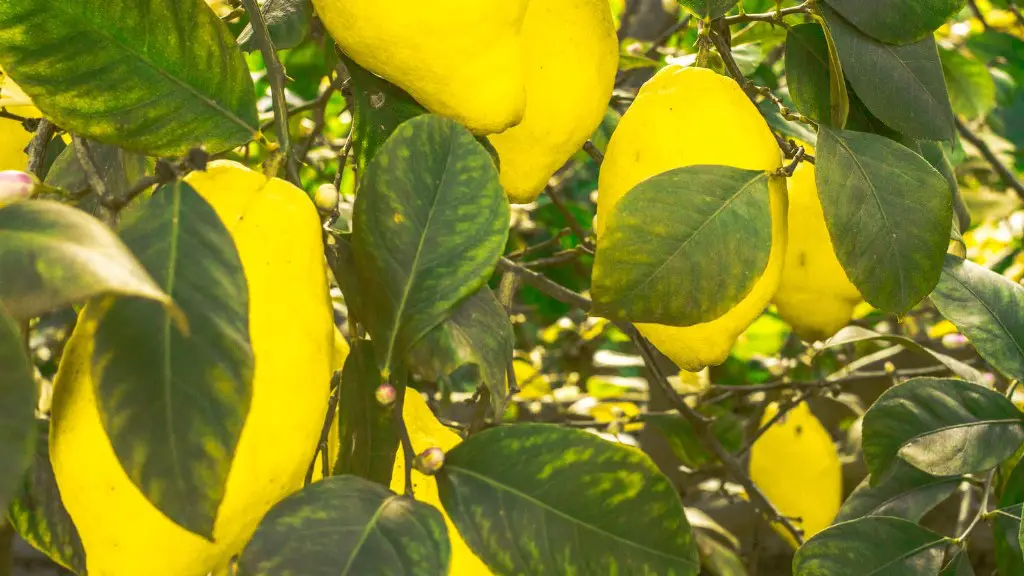Lemon tree leaves are a distinctive part of the citrus tree that helps to identify itimmediately. They typically have a deep, glossy green color with a very subtle intricate grain pattern. The shape of the leaves can vary, but typically they are oblong in shape and can range in size from small to large. Along their edge, you may find small indentations, pointed ‘teeth’, and serrations. The underside of the leaves usually has a much lighter color than the upper side.
The beauty of the lemon tree leaves is that they can vary significantly from one tree to the next. In fact, if you look closely at two different specimens of leaves from the same tree, you’ll also find small variations in color and shape, with some having a much more distinct pattern than others. This makes for a unique and interesting visual experience for both the casual observer and experienced horticulturist.
The reason for the variations in lemon tree leaves is primarily due to the environment and climate in which the tree is growing. In tropical and subtropical climates the leaves of citrus trees tend to have a more ‘jagged’ edge when compared to those grown in more temperate climates. Additionally, the amount of sunlight and water available to the tree can also affect the texture and shape of the leaves, with those trees that receive more rain and a higher intensity of light having thicker leaves than those receiving dryer conditions.
The final factor to consider when looking at lemon tree leaves is their age. Young lemon trees tend to have a smoother, more rounded shape and hardly any of the distinctive edge serrations, while older trees will have leaves with more deeply rooted patterns – especially along the edge. As the tree matures, the leaves may also become slightly thicker, with a waxy texture that helps to protect it from drying out in harsher climates.
When selecting a lemon tree for your garden or windowsill, it is important to remember that the shape and texture of the leaves may change significantly from season to season and even from year to year. This is all part of the unique character of the lemon tree, and it’s something to be celebrated rather than seen as a problem. With the right combination of sun and water, you can be sure that your lemon tree will flourish and provide you with juicy lemons for years to come.
Types of Lemon Tree Leaves
When picking a lemon tree for your garden or interior decor, it is important to know the different types of leaves they can have. The most common variety of lemon tree leaves are oblong and serrated on the edges, with a glossy green color on the upper side and a lighter hue on the underside. These tend to be thick and waxy in appearance and will show more of the intricate patterns as the tree matures. However, there are some varieties of citrus trees with leaves that are more rounded than others, such as the Ayous type.
Alternatively, if you’re looking for something a bit more unusual, the Ponderosa Lemon tree is recognizable by its star-shaped leaves, which have points along the edges. These typically have a bright yellowish-green color and are quite soft to touch – making them perfect for indoor cultivation, where they can bring a splash of color to any room. Regardless of the variety you choose, it is important to always check the underside of the leaves to ensure there are no pests or parasites living underneath.
The most important thing about lemon tree leaves isn’t the color or shape, but rather the fact that they are an important part of the tree’s reproductive cycle. They help to absorb nutrient from the soil and, together with other parts of the tree, are essential for producing juicy lemons. For this reason, it is important to make sure you give them the right amount of sun and water for optimal growth and health.
Caretaking Tips for Lemon Tree Leaves
If you are lucky enough to have a lemon tree in your garden, you will want to make sure you take proper care of its leaves. This is best done by ensuring the tree is planted in an area where it can receive plenty of sunlight, with enough moist soil to keep the leaves well hydrated. Watering should be done regularly but with caution to avoid over-watering, and fertilizer can be used to provide essential nutrients to the tree.
When it comes to pruning trees, it is essential not to over-prune the lemon tree leaves, as this can cause permanent damage to the tree. It is also important to remember that while young lemon tree leaves are usually more delicate, this is not always the case, and pruning them off can be beneficial for both their health and the appearance of the tree. Finally, it is important to check the leaves regularly for any signs of pests or diseases, and to take the appropriate action if any suspicions are found.
Significance of Lemon Tree Leaves
Lemon tree leaves don’t just add visual interest to the citrus tree, but are also extremely significant in terms of their horticultural and agricultural benefits. As we’ve discussed, they play an important role in helping the tree to absorb micronutrients from the soil. They also help to keep the tree healthy and robust by providing protection from extreme weather conditions, acting as a barrier to ultraviolet radiation, wind and pests.
At the same time, lemon tree leaves can also be used for culinary purposes. If removed in the right way, they can be dried and ground into a powder that can be added to dishes to give them a sour, citrusy flavor. Alternatively, the leaves can also be chopped up and added to salads and other foods, providing a nutritious and delicious topping.
Finally, lemon tree leaves are also a valuable resource for some local communities. In certain regions of the world, these leaves are used to make special types of tea, which can act as a sort of natural remedy for various ailments such as colds and flu. Additionally, the trees themselves can be a source of income, as the fruits and leaves can be sold or traded, providing income for those who need it most.
Prevention of Diseases in Lemon Tree Leaves
Like any other plant, lemon trees can become vulnerable to certain diseases or pests, especially if maintained badly or exposed to too much heat. The most common diseases affecting lemon tree leaves are wilt, leaf spots, and powdery mildew. All of these can be prevented through proper maintenance of the tree and other citrus plants nearby, as well as ensuring adequate space between plants and trees.
In order to prevent wilt, it is important to ensure the tree is planted in moist, well-draining soil, and that it receives enough water – but not too much – every day. Additionally, providing shade or wind protection can help to protect the leaves from harsh sunlight or strong winds. For leaf spots, which tend to be caused by fungal or bacterial infections, prevention can be achieved by limiting the amount of rainfall the leaves receive and by avoiding overwatering.
Powdery mildew can also affect lemon trees, and it is important to act quickly in order to limit any damage it may cause. The most effective way of dealing with powdery mildew is to provide the tree with adequate sunlight, as this helps the leaves to dry and thus makes it more difficult for spores to reproduce. If the mildew does take hold, it is important to remove any affected leaves immediately in order to limit the spread.
Preservation of Lemon Tree Leaves
Lemon tree leaves can be preserved for a number of uses, such as decoration or culinary purposes. The best way to preserve them is by drying them out and using them in floral arrangements. This is done by laying out the leaves on a flat surface, preferably somewhere that gets plenty of sunlight, and leaving them for a few days – ensuring they don’t receive too much direct sunlight in order to avoid damage. Once completely dry, the leaves can then be used for any purpose.
In addition to dried leaves, lemon tree leaves can be also preserved in glycerin. This is a process that involves soaking the leaves in a mixture of water and glycerin for several days, after which they can be removed and hung to dry. The glycerin helps to prevent the leaves from becoming brittle and prevents them from breaking, while also preserving their color and texture. This makes them perfect for a range of craft ideas and interior decor ideas.
Finally, lemon tree leaves can be preserved in oil. This type of preservation involves soaking the leaves in a mixture of oil and alcohol for several days, after which they can be hung up to dry. This method helps to preserve the color and texture of the leaves, making them ideal for display purposes. The preserved leaves can then be used for a wide range of decorative crafts and other purposes.




